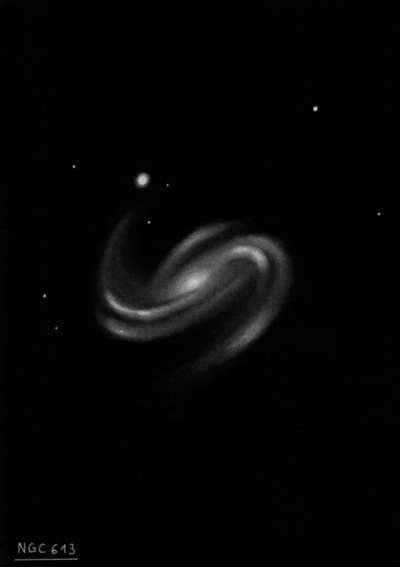
William Herschel discovered NGC 613 = H I-281 = h139 = h2422 on 9 Dec 1798 (sweep 1084) and recorded "cB, E np-sf, 5 or 6' long, 1 1/2' broad, a nucleus in the middle, A pretty considerable star is about 3' north of it, and a little following." James Dunlop independently found the galaxy on 5 Aug 1826 with his 9-inch f/12 speculum reflector and recorded "a very small round nebula, about 15" diameter, pretty well defined, bright at the center." Stephen O'Meara notes it is curious that Dunlop failed to note any elongation and didn't mention its proximity to the 10th magnitude star just off its NE flank.
John Herschel observed the galaxy both at Slough and at the Cape of Good Hope. On 27 Sep 1834, his Cape observation reads "vB; vL; vmE; pos 118.3 ; 1st gradually then suddenly much brighter to the middle to a nucleus 4' long 1.5' broad, has a star 9th mag N.f." He also noted that the position assigned in his Slough Catalogue was incorrect. On a second sweep, he logged "pB; vmE; pslbM, 2 1/2' length. No other near it within 3 fields in RA and 1 field's breadth in declination." Finally on a third sweep he logged "vB; L; vmE; pspmbM; has a *10; N.F."
200/250mm - 8" (11/28/81): faint, moderately large, diffuse, small bright core. A mag 9 star lies 2.5' NE.
400/500mm - 17.5" (12/4/93): fairly bright, very elongated 3:1 WNW-ESE, 4.0'x1.3', prominent elongated core, almost stellar nucleus with direct vision. The halo is broader with averted vision. There appeared to be a very faint extension or large knot southeast of the core . The DSS reveals this feature to be the bright spiral arm extending southeast from the central bar. Located 2.4' SW of mag 9 SAO 167149.
600/800mm - 30" (10/15/15 - OzSky): this very large barred spiral was a stunning showpiece at 303x! The bright central bar region is oriented NW-SE and extends ~2.5'x1' with the halo and arms stretching ~5'x3.6'. The central region was sharply concentrated with a very intense oval core that increased to a bright stellar nucleus. A prominent spiral arm was easily visible on the southeast end. It had a well defined edge and a high contrast as it emerged from the central region and unfurled east and north. The arm then dimmed significantly but could be followed as it bent backwards on the east side towards the northwest! The arm faded away before reaching a mag 9.6 star (SAO 167149) 2.2' NE of center. A second relatively bright, well-defined arm is attached on the northwest end of the bar and it curled south on the west end of the halo.
Notes by Steve Gottlieb